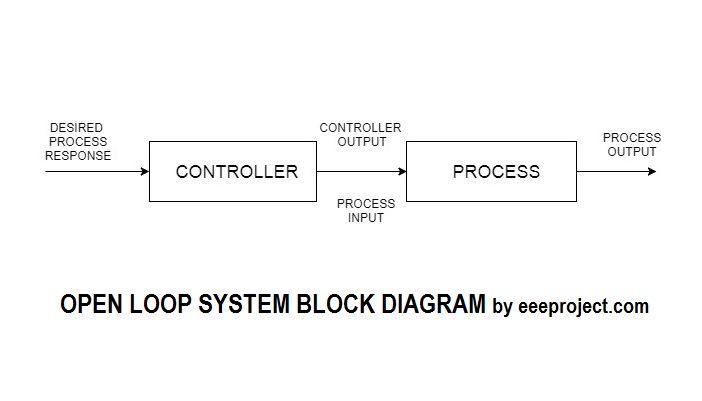Systems & its Type
Let us start with the concept of the system. The system is a collection of different subsystems that combines to achieve some particular result. For example, if a fan has to rotate at a speed of 1000 rpm then its rotation is the system and its speed is the desired output.
In general, there are two types of control systems, namely open-loop and closed-loop systems. Open-loop is the one that has no feedback or error rectification. This means if the fan speed goes down/up by some external disturbance then in an open-loop system there is no scheme to reach the setpoint (1000 rpm here) again.
Unlike this, a closed-loop system has error management,i.e., the error will go to the controller, and error will be compensated so that the desired output is always tracked.
Open Loop System
The open-loop system also has a feedback system but not connected and is used just for measurement. Generally, the feedback is considered as unity and that’s why many think that the system doesn’t have a feedback. But just give a thought if measuring instrument is not present then how we’ll get the value.
It is referred to as an open-loop feedback system because here the output is not being used as the control variable; this type of system does not depend on their output.
Transfer Function of Open Loop System

Let us calculate the Overall Transfer Function of the open-loop system. As the blocks are cascaded, therefore overall transfer function will be the product of individual blocks.
G1 = ø1/ øi ,G2 = ø2/ø1 ,G3 = øo/ø2
Overall Transfer Function = G1*G2*G3
= (ø1/øi)*(ø2/ø1)*(øo/ø2) = øo/øi
This is also called as Open Loop Gain (here feedback is taken as unity).
Open Loop control system suits for the processes which require the sequencing of events with ON-OFF commands. For instance, a water level tank where the valve gets open and once the tank is full the valve gets OFF followed by the next process in the sequence (say heating for some application) and so on.
Components of an open loop system
- The controller which can be a timer
- Processor
- Input unit
- Output unit
- Heating elements
Examples of open loop system
There are end numbers of applications of open-loop systems in our day to day life. We all have used the devices and appliances which work on this simple and amazing system function. The best thing about using this system is cost-effectiveness.
Some of the examples of an open-loop system which we all have heard of are mentioned below:
- Clothes drier
- Electric bulb
- Automatic washing machine
- Bread toaster (time-based)
- Electric hand drier
- Door lock systems
- Servo motors
- Remote control of TV
- Inkjet printers
- Word processor
- Controlling the volume of the audio systems
- Water faucet
- Mobile phones
Working of a Cloth Drier Machine

The concept of the open-loop system is used in automatic clothes drier machines because it does not depend on the output that is it will stop according to the set time, no matter what the condition of the cloth is.
For an automatic washing direr to work and dry the clothes. We prefix the timing which is needed by our clothes to dry off. Suppose 20 minutes is the time duration we have set, and then the machine will automatically stop as soon as it completes 20 minutes. It will not keep on rotating if the clothes are not dry because it works on the concept of the open-loop system where the output has no effect on the input.
The cloth drier machine has basically three main units that are
- Timer
- Heating elements
- Clothes
As the feedback path is open here it doesn’t care about the feedback of the clothes. It will stop working as per its pre-set time, not considering the condition of the clothes (that whether they are still wet or dried up).
Benefits of using an open loop system
- These are cost-effective and keeps doing the process in the loop. These works on the ideal conditions where there is no disturbance.
- Open Loop systems are easy to design.
- There is almost no maintenance charge as once made these systems work until its aging.
- These systems are fast and most stable.
Disadvantages of Open Loop System
- In the real world, things are not ideal, i.e., disturbances are obvious to happen which open-loop system doesn’t care about.
- It can’t be used at a place where the accuracy of the output is of high importance. This is because it doesn’t count on disturbance.
- With aging, things get worsen in an open-loop system.
- All these disadvantages can be overcome by making it a closed-loop system. This is done by connecting the feedback path to the input.
I hope you are good with the concepts now. So, I have an assignment for you then! Excited!! Do read the next article Closed Loop System and answer the following question.
“Whether the nervous system of a Mental person is an open-loop or a closed-loop system“. Waiting for your responses in the comment section below. Let’s see if you are able to think or not!


2 thoughts on “Open Loop System [Explained] in Detail”
I want to make an open loop system, just to learn. Is the above circuit just fine to start for me ? Thank you.
yes it works.